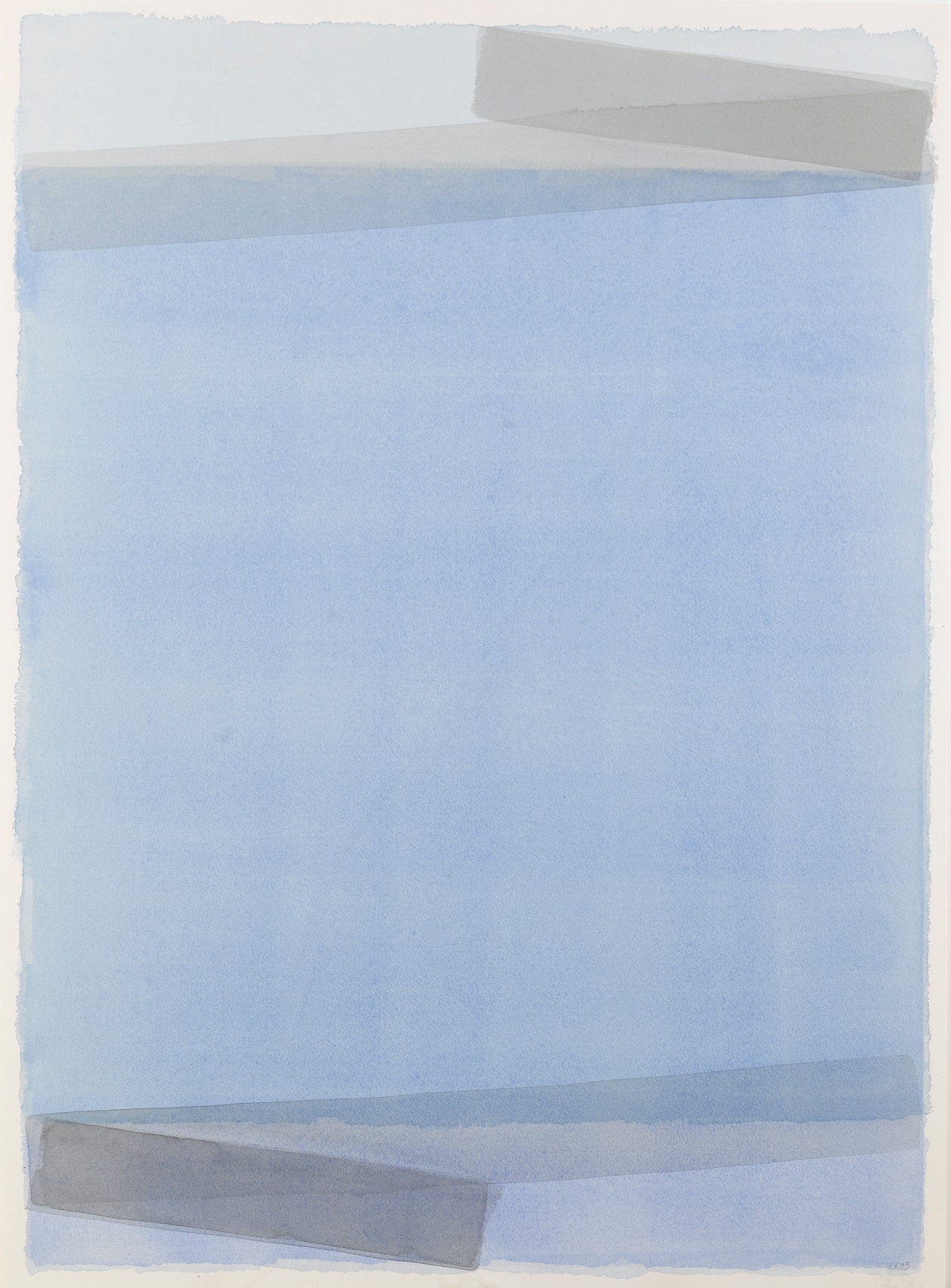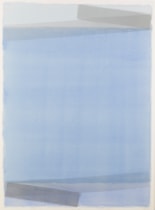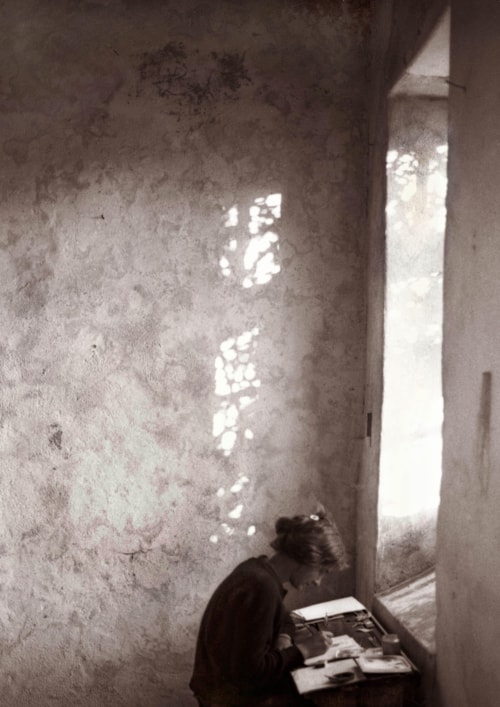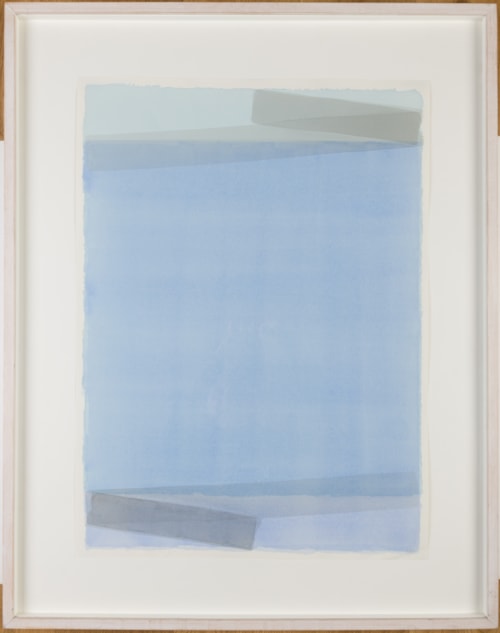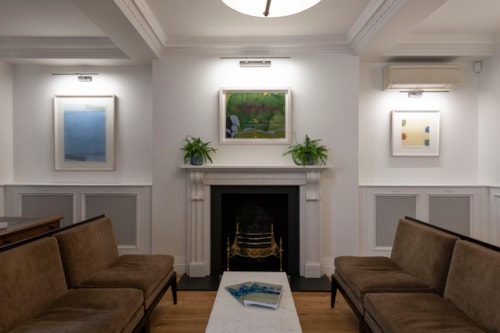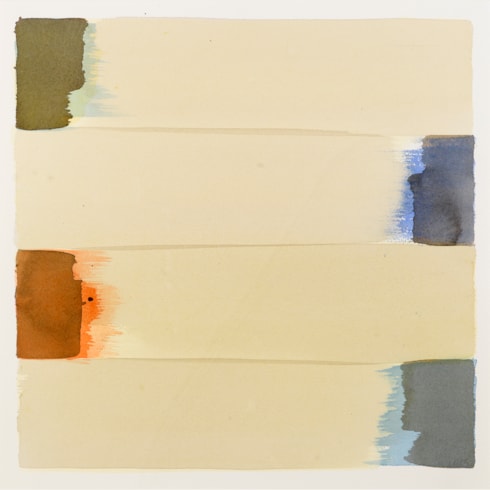Libby RAYNHAM
(Kent 1952)
Ultramarine
Watercolour.
Signed with initials and dated LR05 at the lower right.
725 x 530 mm. (28 1/2 x 20 7/8 in.) [sheet]
Signed with initials and dated LR05 at the lower right.
725 x 530 mm. (28 1/2 x 20 7/8 in.) [sheet]
Writing in 2006, the year after the present sheet was completed, the artist and museum curator Michael Wilson noted that, ‘For over three decades, Libby Raynham has pursued her artistic course, honing her skills, without regard to critical or commercial success, driven solely by the need to express herself and to be true to herself. ‘Painting is for me’, she says, ‘a matter of necessity’…[She] is extremely reluctant to talk about her paintings: ‘it is in painting and not in words that I find my voice.’ Her titles come after the works, not before, and are intended to help the viewer find a way in. The inspiration is wordless. Nevertheless, as she herself acknowledges, the paintings have their origin in her experience, and in particular her encounter with nature in its myriad forms. She is acutely alive to nature and to light, atmosphere and weather conditions, but the places and memories that inform her work above all others are those for which she feels deepest affection, the orchards and hop gardens of Kent where she grew up, the vineyards of France, the moors of Scotland and ‘everywhere the sea’. Perhaps it is because she has lived in land-locked Switzerland for almost thirty years that these remembered landscapes and seascapes have such a hold on her.’
As Wilson adds, Raynham ‘records her initial ideas in books she makes herself, journals in effect, briefly noting an arrangement of shapes and colours in direct watercolour brushstrokes. These ideas are then pondered on and developed over time, often in series of paintings. The process is long and involves periods of quiet and contemplation interspersed with moments of confident, fluent execution – like a performance. Not for nothing has she long been an admirer of the deft brushstrokes of Chinese painting. She is respectful of her materials – her paints, her brushes, and her paper – and is exact and masterful in their use, but the act of painting is driven by intuition, so that every painting is an exploration, a journey of discovery…it is in a free, gestural brushstroke across a field of watercolour wash that we can sense the movement of the hand of the artist and at the same time her presence, as she ventures into the imagined space of her art…in the predominant colour of a painting, in a tawny pink or greeny-blue, we may find a clue to the memory of a season or of the sea that feeds into it, a clue that is reinforced by an evocative and sometimes enigmatic title…But the context of the paintings, if we can call it that, is thoroughly subjective; they are about the experience of the artist herself – her memories, thoughts, sensations and feelings in her encounter with the world, and her sense of herself as part of nature.’
As Raynham has noted elsewhere, although the watercolour medium leaves little margin for error, ‘Every now and then a mistake may happen that leads to a new idea, but the aim of the painting process remains to realize an inner idea.’
This large watercolour was drawn between 2004 and 2005.
As Wilson adds, Raynham ‘records her initial ideas in books she makes herself, journals in effect, briefly noting an arrangement of shapes and colours in direct watercolour brushstrokes. These ideas are then pondered on and developed over time, often in series of paintings. The process is long and involves periods of quiet and contemplation interspersed with moments of confident, fluent execution – like a performance. Not for nothing has she long been an admirer of the deft brushstrokes of Chinese painting. She is respectful of her materials – her paints, her brushes, and her paper – and is exact and masterful in their use, but the act of painting is driven by intuition, so that every painting is an exploration, a journey of discovery…it is in a free, gestural brushstroke across a field of watercolour wash that we can sense the movement of the hand of the artist and at the same time her presence, as she ventures into the imagined space of her art…in the predominant colour of a painting, in a tawny pink or greeny-blue, we may find a clue to the memory of a season or of the sea that feeds into it, a clue that is reinforced by an evocative and sometimes enigmatic title…But the context of the paintings, if we can call it that, is thoroughly subjective; they are about the experience of the artist herself – her memories, thoughts, sensations and feelings in her encounter with the world, and her sense of herself as part of nature.’
As Raynham has noted elsewhere, although the watercolour medium leaves little margin for error, ‘Every now and then a mistake may happen that leads to a new idea, but the aim of the painting process remains to realize an inner idea.’
This large watercolour was drawn between 2004 and 2005.
Born in the village of Lenham in Kent, the painter, draughtsman and printmaker Elizabeth Anne (‘Libby’) Raynham studied at the Slade School of Art in London between 1970 and 1974, winning the David Murray Prize for landscape painting at the Royal Academy in 1972. It was while she was studying at the Slade that she began to produce abstract compositions, which were studied and developed in a series of illustrated notebooks or journals; a practice she has maintained throughout her later career. Raynham has worked in France and on the Aegean island of Samothrace in Greece, but from 1977 onwards has lived and worked in Zurich, Switzerland, following her marriage the late architect René Haubensak. She had her first solo exhibition in a gallery in London in 1979 and has since regularly exhibited her work in solo and group exhibitions in London and Zurich, most recently in 2019 and 2022. Her work is also included in the Deutsche Bank corporate collection in London and is on public view in the Hirslanden Clinic in Zurich.
As the artist and museum curator Michael Wilson has noted of Raynham’s work, ‘Some art is immediate and forceful in its impact on the viewer; some is slow, quiet and mysterious in its working. Libby Raynham’s watercolours are of the second kind. As she herself has said, ‘they are there to be contemplated, just as contemplation plays an important part in their making.’ They are abstract and on first encounter may seem baffling – the discreet expression of a private world. While the beauty of the colour and the handling is evident, they are neither simply pretty nor effusive. This is serious art, produced with rigour and dedication, and as such it makes few concessions to the viewer. It requires a serious response, which entails concentration, openness and humility. But it amply rewards such a response, because this art is heartfelt and authentic.’
As the artist and museum curator Michael Wilson has noted of Raynham’s work, ‘Some art is immediate and forceful in its impact on the viewer; some is slow, quiet and mysterious in its working. Libby Raynham’s watercolours are of the second kind. As she herself has said, ‘they are there to be contemplated, just as contemplation plays an important part in their making.’ They are abstract and on first encounter may seem baffling – the discreet expression of a private world. While the beauty of the colour and the handling is evident, they are neither simply pretty nor effusive. This is serious art, produced with rigour and dedication, and as such it makes few concessions to the viewer. It requires a serious response, which entails concentration, openness and humility. But it amply rewards such a response, because this art is heartfelt and authentic.’

